
Photo from wikipedia
The increase in impervious areas caused by urbanization causes the amount of surface rainfall-runoff and nonpoint source (NPS) pollutant discharge to also increase. This issue has sparked a growing interest… Click to show full abstract
The increase in impervious areas caused by urbanization causes the amount of surface rainfall-runoff and nonpoint source (NPS) pollutant discharge to also increase. This issue has sparked a growing interest in low impact development (LID) technology and NPS reduction technology. The objective of this study is to analyze the ability of a hybrid system to achieve both rainfall-runoff and NPS pollutant reduction simultaneously. The results indicate that this system is effective in reducing particulate matter with a relatively small particle size (less than 64 μm), which plays an important role in reducing NPS pollution. It is expected that a LID-based urban water cycle recovery policy could be established through further research on various hybrid system configuration methods and socioeconomic effect analysis.
Journal Title: Desalination and Water Treatment
Year Published: 2020
Link to full text (if available)
Share on Social Media: Sign Up to like & get
recommendations!